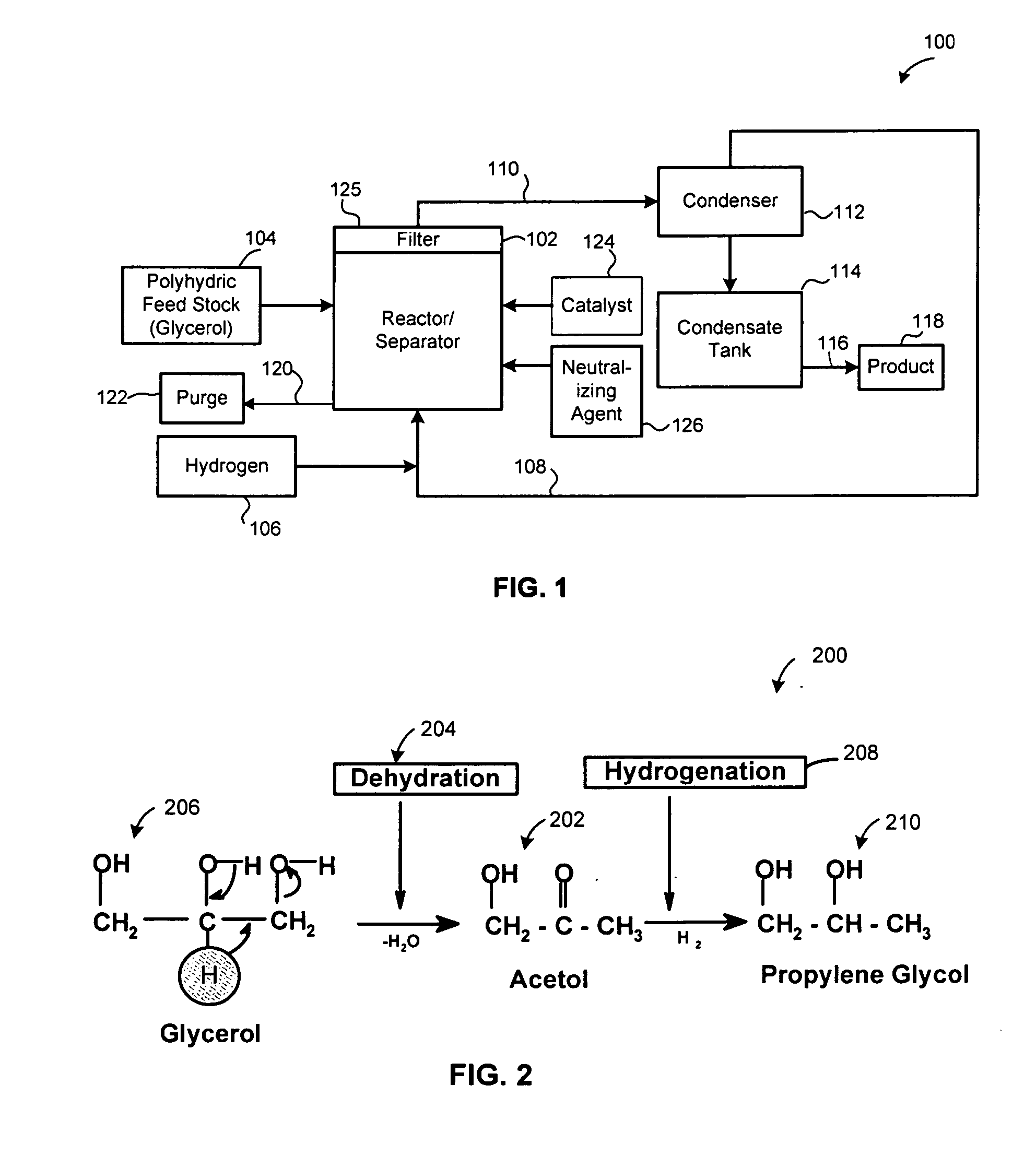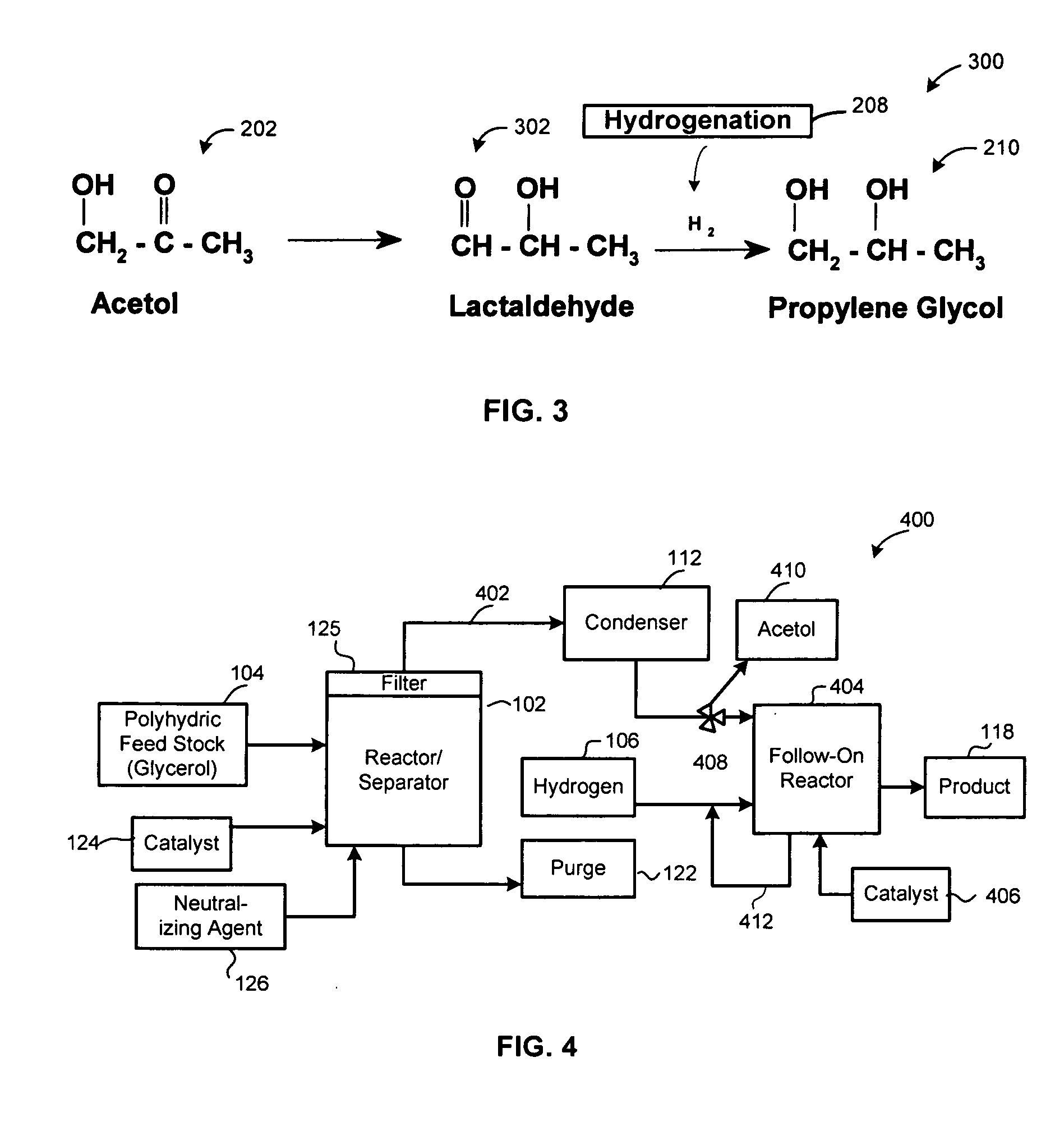Method of producing lower alcohols from glycerol
a technology of glycerol and alcohol, which is applied in the preparation of carbonyl compound, oxygen-containing compound preparation, and preparation by oh group elimination. it can solve the problems of unsuitable process conditions and reactions, none of the processes and none of the process shown by these patents provides a direct reaction product mixture suitable for antifreeze use, and achieves high selectivity
- Summary
- Abstract
- Description
- Claims
- Application Information
AI Technical Summary
Benefits of technology
Problems solved by technology
Method used
Image
Examples
example 1
Confirmation of Reaction Mechanism
[0037] An experiment was performed to validate the reaction mechanism 200. Reactions were conducted in two steps, namely, Steps 1 and 2. In step 1, relatively pure acetol was isolated from glycerol. Temperature ranged from 150° C. to 250° C. and more specifically from 180° C. to 220° C. There was an absence of hydrogen. Pressure ranged from 1 to 14 psi (6.9 MPa to 96 MPa) more specifically from 5 to 10 psi (34 MPa to 69 MPa). A copper-chromite catalyst was present. In Step 2, the acetol formed in Step 1 was further reacted in presence of hydrogen to form propylene glycol at a temperature ranging from 150° C. to 250° C. and more preferably between 180 to 220° C. Excess hydrogen was added at a hydrogen over pressure between 1 to 25 bars using the same catalyst.
[0038] It was observed in the Step 2 of converting acetol to propylene glycol that lactaldehyde was formed. Propylene glycol is also formed by the hydrogenation 208 of lactaldehyde 302, as ill...
example 2
Simultaneous Dehydration and Hydrogenation Using Various Catalysts and Reagent Mixtures
[0040] A variety of reaction procedures were performed to show that reaction efficiency may be optimized at any process conditions, such as reaction time, temperature, pressure and flash condition by the selection or choice of catalyst for a given polyhydric feedstock.
[0041] Table 1 reports the results of reacting glycerol in the presence of hydrogen and catalyst to form a mixture containing propylene glycol. The reaction vessel contained 80 grams of refined glycerol, 20 grams of water, 10 grams of catalyst, and a hydrogen overpressure of 200 psig. The reactor was a closed reactor that was topped off with excess hydrogen. The reaction occurred for 24 hours at a temperature of 200° C. All catalysts used in this Example were purchased on commercial order and used in the condition in which they arrived.
TABLE 1Summary of catalyst performances based on 80 gramsof glycerol reported on a 100 grams ba...
example 3
Processing of Biodiesel Byproduct
[0067] Crude glycerol obtained as a by product of the biodiesel industry was used instead of refined glycerol. Biodiesel is produced using alcoholysis of bio-renewable fats and oils. The composition of feedstock 104 used in this example had an approximate composition as follows: glycerol (57%), methyl alcohol (23%), and other materials (soaps, residual salts, water) (20%). The above feedstock was reacted in the presence of hydrogen and catalyst to form a mixture containing propylene glycol. The reaction proceeded using 10 grams of the crude feedstock, 5% by weight of catalyst, and a hydrogen overpressure of 1400 kPa. The following Table 6 presents compositions after reacting in a closed reactor (with topping off of hydrogen) for 24 hours at a temperature of 200° C. The copper chromium catalyst used in this Example was reduced in presence of hydrogen at a temperature of 300° C. for 4 hours prior to the reaction.
TABLE 6Summary of catalyst performanc...
PUM
| Property | Measurement | Unit |
|---|---|---|
| pressure | aaaaa | aaaaa |
| pressure | aaaaa | aaaaa |
| temperature | aaaaa | aaaaa |
Abstract
Description
Claims
Application Information
 Login to View More
Login to View More - R&D
- Intellectual Property
- Life Sciences
- Materials
- Tech Scout
- Unparalleled Data Quality
- Higher Quality Content
- 60% Fewer Hallucinations
Browse by: Latest US Patents, China's latest patents, Technical Efficacy Thesaurus, Application Domain, Technology Topic, Popular Technical Reports.
© 2025 PatSnap. All rights reserved.Legal|Privacy policy|Modern Slavery Act Transparency Statement|Sitemap|About US| Contact US: help@patsnap.com



